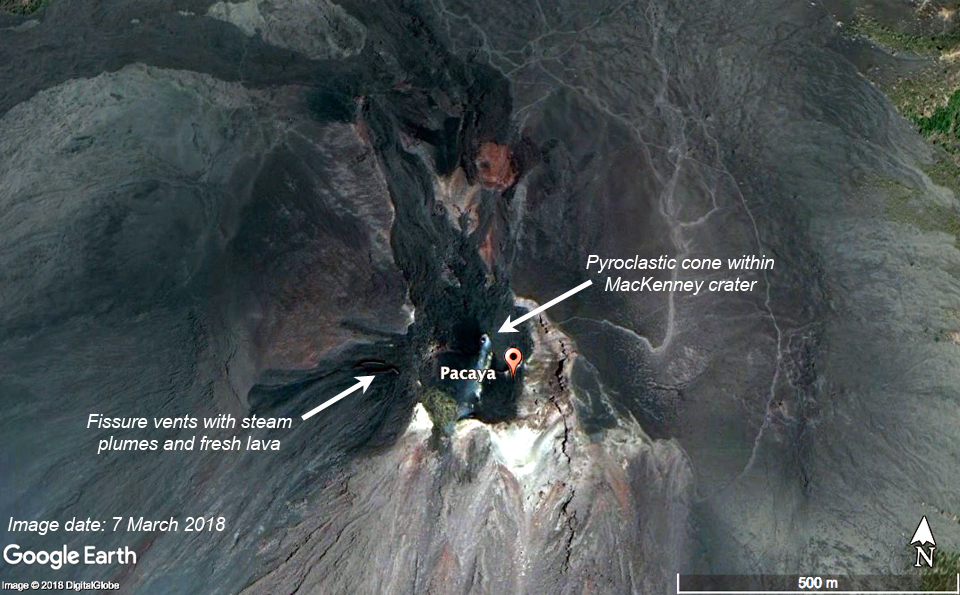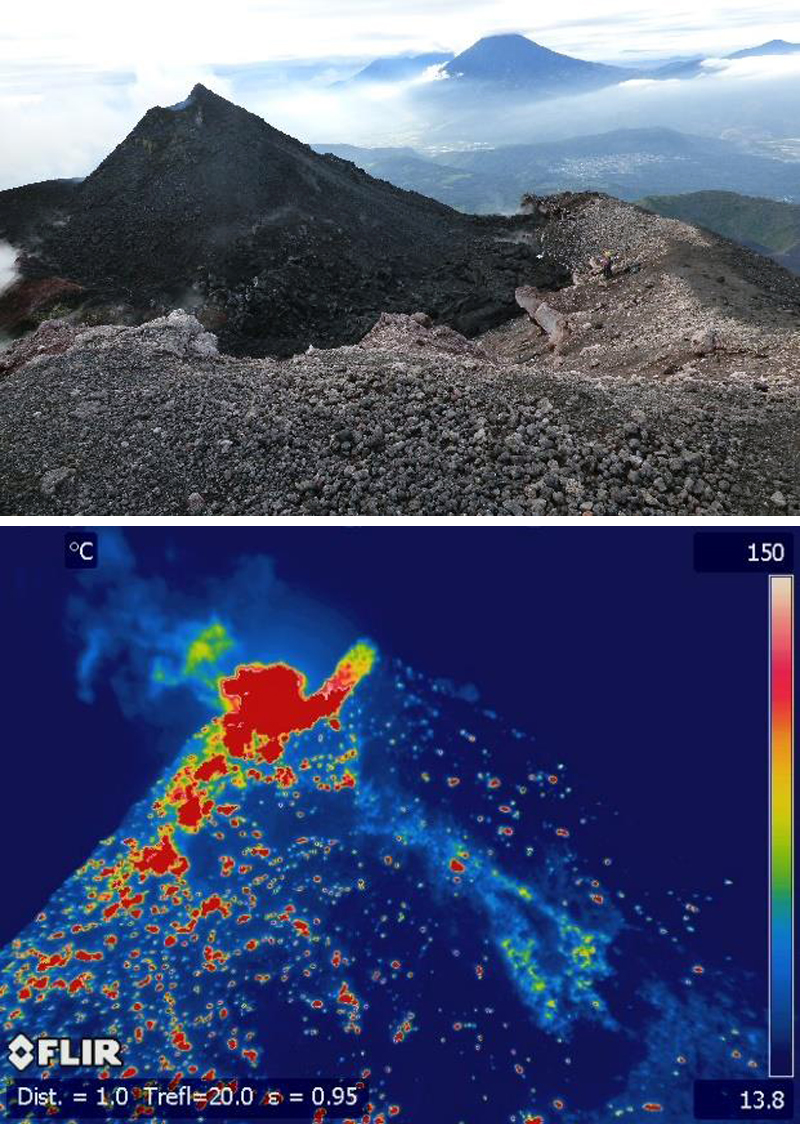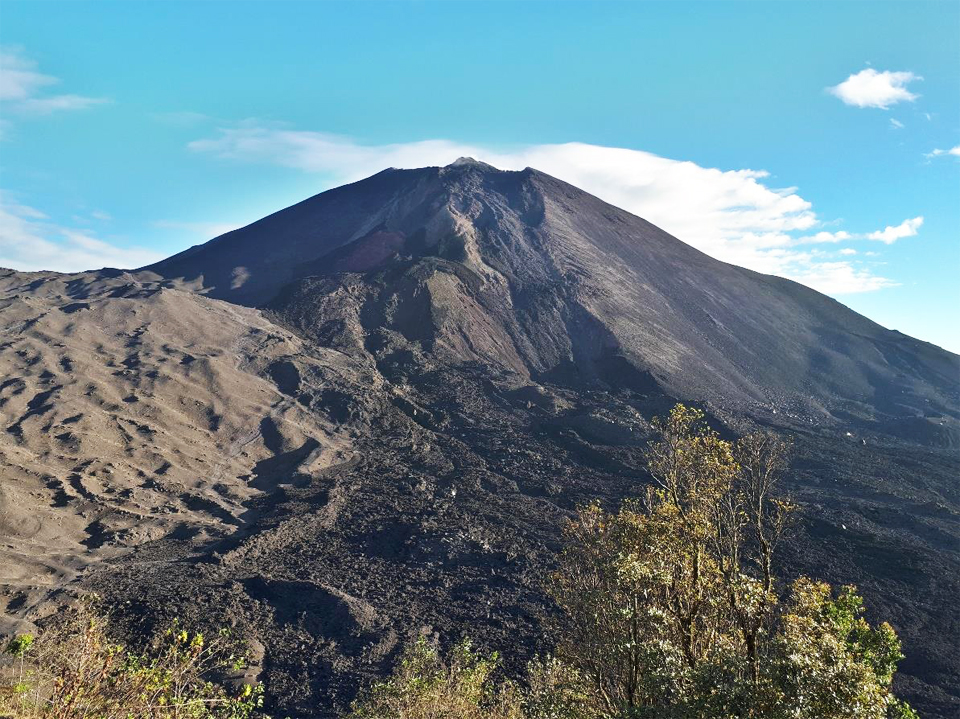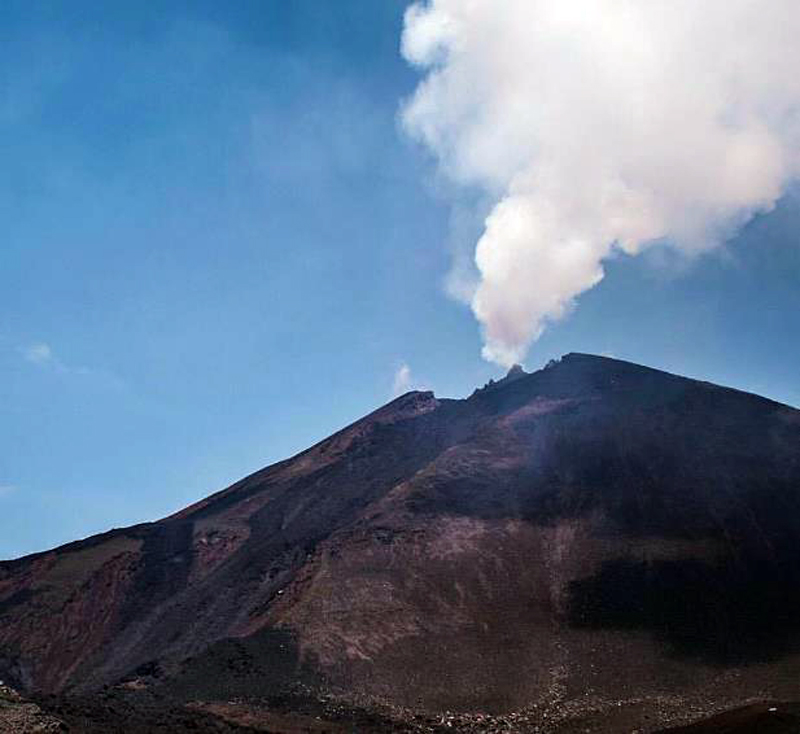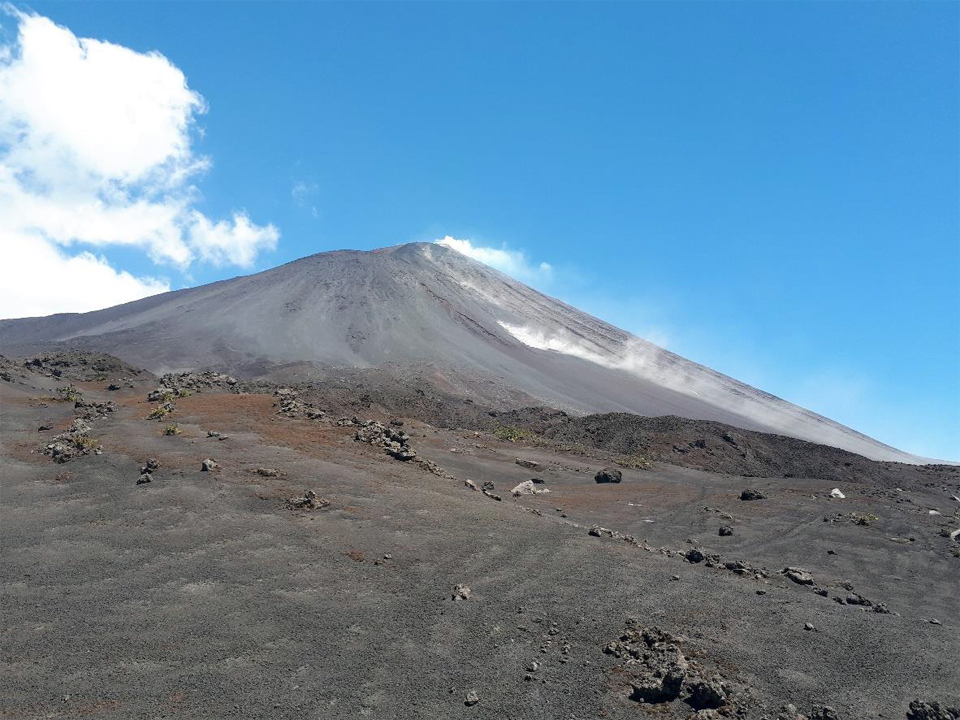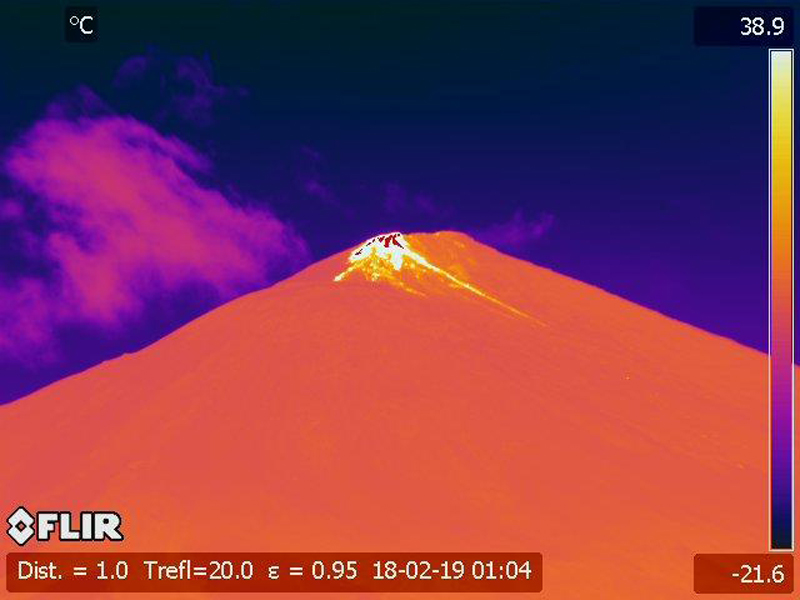Report on Pacaya (Guatemala) — May 2018
Bulletin of the Global Volcanism Network, vol. 43, no. 5 (May 2018)
Managing Editor: Edward Venzke.
Edited by A. Elizabeth Crafford.
Pacaya (Guatemala) Pyroclastic cone fills MacKenney crater; lava flows emerge from fissures around the crater rim
Please cite this report as:
Global Volcanism Program, 2018. Report on Pacaya (Guatemala) (Crafford, A.E., and Venzke, E., eds.). Bulletin of the Global Volcanism Network, 43:5. Smithsonian Institution. https://doi.org/10.5479/si.GVP.BGVN201805-342110
Pacaya
Guatemala
14.382°N, 90.601°W; summit elev. 2569 m
All times are local (unless otherwise noted)
Extensive lava flows, bomb-laden Strombolian explosions, and ash plumes emerging from MacKenney crater have characterized persistent activity at Pacaya since 1961. The latest eruptive episode began with intermittent ash plumes and incandescence in June 2015; the growth of a new pyroclastic cone inside the summit crater was confirmed in mid-December 2015. Strombolian activity from the cone continued during 2016 and it grew sporadically through September 2017 (BGVN 42:12). Lava flows first emerged from fissures around the summit during January-April 2017. Explosions from the cone summit caused growth and destruction of the top of the cone; by the end of September it was about 10 m above the elevation of the crater rim. This report describes the continued growth of the pyroclastic cone and the increasing emergence of lava flows around the summit during October 2017-March 2018. Information was provided primarily by the Instituto Nacional de Sismologia, Vulcanologia, Meteorologia e Hydrologia (INSIVUMEH) and satellite thermal data.
Thermal activity was relatively quiet at Pacaya during October and November 2017. The pyroclastic cone inside MacKenney crater continued to grow as material from Strombolian explosions sent ejecta a few tens of meters above the cone and onto its flanks, slowly filling the area within the crater. In late November, small lava flows began to emerge from the crater. Material flowed from the 2010 fissure on the NW side of the crater, and also appeared from new lateral fissures on the W and SW flanks. Multiple small short-lived lava flows traveled a few hundred meters down the flanks with increasing frequency during January through March 2018. Strombolian activity from the summit of the cone occasionally reached over 100 m; by the end of March, the summit of the cone remained about 25 m above the crater rim, and much of the crater was filled with ejecta (figure 84).
Activity during October-December 2017. Activity during October 2017 consisted primarily of degassing with small plumes of steam and gas rising 100 m above the summit, and weak Strombolian explosions. . By the end of the month, the cone inside MacKenney crater rose about 10 m above the crater rim. At night, incandescent ejecta could be seen 25-100 m above the summit of the cone. During the last week of October strong winds dispersed the plumes SW and SE, and ashfall was reported 2 km from the crater in El Rodeo.
Steam and gas plumes generally rose no more than 25 m above the summit for the first 20 days of November 2017. Beginning on 21 November, more substantial steam and gas plumes, rising 500 m, were observed in the webcam (figure 85). An increase in tremor activity on 28 November coincided with an increase in explosive activity, a gray ash plume, and the appearance of a small lava flow on the NW flank that extended about 30 m. By the end of the month the cone had reached about 25 m above the rim of MacKenney crater and continued to grow from the accumulation of tephra fragments ranging in size from one millimeter to 50 cm that were ejected 25-100 m above the summit (figure 86). Explosions could be heard up to 1 km from the cone.
Strombolian explosions rising to 25 m continued in early December. On 10 December 2017, INSIVUMEH noted that there were two lava flows, one flowing on the SE flank with a length of 50-75 m and a second flowing NW towards Cerro Chino for 75-100 m. Strombolian explosions were reported 100 m above the summit of the cone on 15 December, and 25-50 m high on 25 December. The flow on the NW flank was about 100 m long on 26 December.
Activity during January-March 2018. Weak Strombolian activity continued from the cone during January 2018 with ejecta reaching 50 m above the summit. Small lava flows on the NW flank, generally only a few tens of meters long, were visible as incandescence at night (figure 87). While the height of the cone inside MacKenney crater remained about 25 m above the crater rim, material from the continuing low-level explosions had filled a large area of the crater by the end of the month. Blocks up to 1 m in diameter were also dislodged by the tremors and flow activity on the SW flank of MacKenney crater (figure 88). An increase in explosive activity beginning on 20 January resulted in audible explosions heard 2 km from the cone and fine ash deposited on the flanks. A new, larger flow also emerged from the crater early on 20 January and descended about 400 m down the SW flank, with material spalling off the front as it cooled. The following day, low-level Strombolian activity continued, and the flow remained active 200 m down the SW flank. During the last few days of January, the flow rate decreased, and the active flow was only 25 m long (figure 89).
Low-level steam and occasional gas plumes rising up to 300 m above the summit were typical during February 2018 (figure 90). In addition, intermittent lava flows continued to travel tens to a few hundred meters down the S, SW, and W flanks. A 25-m-long flow was observed on the SW flank on 2 February. On 8 February, a 150-m-long flow was noted, also on the SW flank. INSIVUMEH reported a 300-m-long lava flow from the NW area of crater on 9 February in the region of the 2010 fissure; it traveled NW towards Cerro Chino crater. A flow 75-100 m long was observed on the SW flank on 10 February; the next day 150-m-long flows were visible on both the SW and W flanks. Flows on both flanks were 100 m long on 12 February. A 30-m-long flow appeared on the SW flank on 13 February. The flow on the NW flank that began on 9 February was 20-m-wide and only 50 m long during the afternoon of 14 February. A flow was also visible on 14 February extending 250 m down the SW flank (figure 91).
Multiple lava flows on the SW flank ranged from 50-200 m long during 15-20 February. A flow on the W flank grew from 25 to 150 m during 17-23 February (figure 92). A flow reached 500 m down the SW flank on 25 February and after flow-front collapses was still 300 m long by the end of the month. A new surge of lava on 27 February emerged from the fissure on the NW flank of MacKenney crater and traveled 150 m towards Cerro Chino crater. Explosive activity remained constant; weak explosions, generally 3-5 times per hour, scattered ejecta on the flanks of the cone and created incandescence at night that often reached 15-35 m above the cone. The explosions also generated weak avalanches that sent material up to 1 m in diameter down the S and SW flanks to an area frequented by park visitors. Explosions were sometimes heard up to 3 km from the crater. Strombolian explosions increased in height towards the end of the month; they were reported at 150 m above the summit on 26 February.
Strombolian activity and persistent lava flows throughout March 2018 resulted in continued growth of the pyroclastic cone within the MacKenney crater. Low-level steam and gas plumes generally rose a few tens of meters above the summit; occasional plumes rose as high as 500 m. Small lateral fissures near the crater rim produced repeated small lava flows that generally flowed less than 250 m SW and W. Weak explosions averaging 3-5 per hour sent ejecta 10-50 m above the pyroclastic cone.
During the first week of March, flows on the SW flank were active as far as 500 m down the flank. A flow on 4 March was 65 m long, and one on 5 March ranged from 50-200 m long (figure 93). During the second week, two flows were active to 300 m down the W flank, and two others on the SW flank were 150-200 m long. A flow was reported 200 m down the E flank on 16 March. Multiple lava flows were visible during 17-23 March; one traveled 250 m down the SW flank, two others went 150 m down the W flank and remained active through the end of the month.
Geological Summary. Eruptions from Pacaya are frequently visible from Guatemala City, the nation's capital. This complex basaltic volcano was constructed just outside the southern topographic rim of the 14 x 16 km Pleistocene Amatitlán caldera. A cluster of dacitic lava domes occupies the southern caldera floor. The post-caldera Pacaya massif includes the older Pacaya Viejo and Cerro Grande stratovolcanoes and the currently active Mackenney stratovolcano. Collapse of Pacaya Viejo between 600 and 1,500 years ago produced a debris-avalanche deposit that extends 25 km onto the Pacific coastal plain and left an arcuate scarp inside which the modern Pacaya volcano (Mackenney cone) grew. The NW-flank Cerro Chino crater was last active in the 19th century. During the past several decades, activity has consisted of frequent Strombolian eruptions with intermittent lava flow extrusion that has partially filled in the caldera moat and covered the flanks of Mackenney cone, punctuated by occasional larger explosive eruptions that partially destroy the summit.
Information Contacts: Instituto Nacional de Sismologia, Vulcanologia, Meteorologia e Hydrologia (INSIVUMEH), Unit of Volcanology, Geologic Department of Investigation and Services, 7a Av. 14-57, Zona 13, Guatemala City, Guatemala (URL: http://www.insivumeh.gob.gt/); Google Earth (URL: https://www.google.com/earth/).


